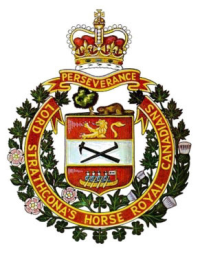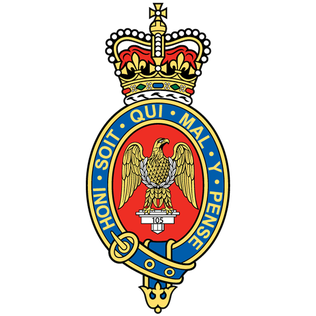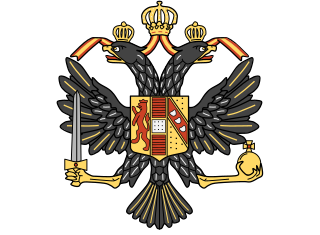A company is a military unit, typically consisting of 100–250 soldiers and usually commanded by a major or a captain. Most companies are formed of three to seven platoons, although the exact number may vary by country, unit type, and structure.

The Welsh Guards, part of the Guards Division, is one of the Foot Guards regiments of the British Army. It was founded in 1915 as a single-battalion regiment, during the First World War, by Royal Warrant of George V. Shortly after the regiment's formation, it was deployed to France where it took part in the fighting on the Western Front until the end of the war in November 1918. During the inter-war years, the regiment undertook garrison duties in the United Kingdom, except between 1929 and 1930 when it deployed to Egypt, and late 1939 when it deployed to Gibraltar.

Lord Strathcona's Horse (Royal Canadians) (LdSH[RC]) is a regular armoured regiment of the Canadian Army and is Canada’s only tank regiment. Currently based in Edmonton, Alberta, the regiment is part of 3rd Canadian Division's 1 Canadian Mechanized Brigade Group. Members of the regiment are commonly called Strathconas or Strats as a short form. It was one of the last regiments in the British Empire to be created and raised by a private individual, Donald Alexander Smith, 1st Baron Strathcona and Mount Royal.

The Blues and Royals (RHG/D) is a cavalry regiment of the British Army, part of the Household Cavalry. The Colonel of the Regiment is Anne, Princess Royal. It is the second-most senior regiment in the British Army.

"Other ranks" is the term used to refer to all ranks below officers in the British Army and the Royal Marines. It includes warrant officers, non-commissioned officers ("NCOs") and ordinary soldiers with the rank of private or regimental equivalent. Officers may, in speaking, distinguish themselves from those "in the ranks".

Soldier Soldier is a British television drama series. Created by Lucy Gannon, produced by Central Television and broadcast on the ITV network, it ran for a total of seven series and 82 episodes from 10 June 1991 to 9 December 1997. It featured the daily lives of a group of soldiers in 'B' Company, 1st Battalion The King's Fusiliers, a fictional British Army infantry regiment loosely based on the Royal Regiment of Fusiliers. The title comes from a traditional song of the same name, an instrumental version of which was used as its theme music.

The Queen's Royal Irish Hussars, abbreviated as QRIH, was a cavalry regiment of the British Army formed from the amalgamation of the 4th Queen's Own Hussars and the 8th King's Royal Irish Hussars in 1958. The regiment saw active service against insurgents in Aden; during the Indonesia–Malaysia confrontation and during the Gulf War, as well as regular service in West Germany as part of the British Army of the Rhine. The regiment was amalgamated with the Queen's Own Hussars to form the Queen's Royal Hussars on 1 September 1993.

The Wooden Horse is a 1950 British World War II war film directed by Jack Lee and starring Leo Genn, David Tomlinson and Anthony Steel. It is based on the book of the same name by Eric Williams, who also wrote the screenplay.

Private's Progress is a 1956 British comedy film directed by John Boulting and starring Ian Carmichael, Peter Jones, William Hartnell and Terry-Thomas. The script was by John Boulting and Frank Harvey based on the novel of the same name by Alan Hackney.

1st The Queen's Dragoon Guards (QDG) is a regiment in the Royal Armoured Corps of the British Army. Nicknamed The Welsh Cavalry, the regiment recruits from Wales and the bordering English counties of Cheshire, Herefordshire, and Shropshire, and is the senior cavalry regiment, and therefore senior regiment of the line of the British Army.

The Royal Dragoon Guards (RDG) is a cavalry regiment of the British Army. It was formed in 1992 by the amalgamation of two other regiments: The 4th/7th Royal Dragoon Guards and the 5th Royal Inniskilling Dragoon Guards. Based in Battlesbury Barracks, Wiltshire, the regiment currently serves as the armoured cavalry reconnaissance unit of 20th Armoured Brigade Combat Team. Previously equipped with the Scimitar armoured reconnaissance vehicle, it started converting to the Warrior tracked armoured vehicle in 2022.

The Royal Canadian Dragoons (RCD) is the senior armoured regiment of the Canadian Army by precedence. It is one of three armoured regiments in the Regular Force and forms part of the Royal Canadian Armoured Corps.

The Ontario Regiment (RCAC) is a Primary Reserve armoured reconnaissance regiment of the Canadian Army. The unit is based in downtown Oshawa, Ontario, and is named after Ontario County (1852–1973). Formed in 1866, and more commonly known as the 'Ontarios', 'black cats' or 'ONT R' (pronounced "ON-tar"), the regiment ranks among the oldest continuously serving Reserve (Militia) regiments in Canada and is one of the senior armoured regiments in the Royal Canadian Armoured Corps.

The 1st King's Dragoon Guards was a cavalry regiment in the British Army. The regiment was raised by Sir John Lanier in 1685 as the 2nd Queen's Regiment of Horse, named in honour of Queen Mary, consort of King James II. It was renamed the 2nd King's Own Regiment of Horse in 1714 in honour of George I. The regiment attained the title 1st King's Dragoon Guards in 1751. The regiment served as horse cavalry until 1937 when it was mechanised with light tanks. The regiment became part of the Royal Armoured Corps in 1939. After service in the First World War and the Second World War, the regiment amalgamated with the 2nd Dragoon Guards in 1959 to form the 1st The Queen's Dragoon Guards.

Ronald Brittain was a regimental sergeant major (RSM) in the British Army. Reported on widely in the newspapers of the day, he featured in several British military training films during the Second World War. He was said to have possibly the loudest voice in the British Army.

Odette is a 1950 British war film based on the true story of Special Operations Executive French agent, Odette Sansom, living in England, who was captured by the Germans in 1943, condemned to death and sent to Ravensbrück concentration camp to be executed. However, against all odds she survived the war and testified against the prison guards at the Hamburg Ravensbrück trials. She was awarded the George Cross in 1946; the first woman ever to receive the award, and the only woman who has been awarded it while still alive.
General Sir James Michael Gow, was a senior British Army officer who served in the Second World War and reached high office in the 1980s, commanding the British Army of the Rhine.

You Lucky People! is a 1955 British comedy film directed by Maurice Elvey and starring Tommy Trinder, Mary Parker and Dora Bryan. Originally titled Get Fell In, the film was renamed to match Trinder's familiar catchphrase. It was shot in a rival French process to CinemaScope, called 'CameraScope', with the attendant publicity describing "the first feature to be made with an anamorphic lens in black and white! It's a camerascoop!". It was shot at Beaconsfield Studios near London with sets designed by the art director Ray Simm.
The 1940 Birthday Honours were appointments by King George VI to various orders and honours to reward and highlight good works by citizens of the British Empire. The appointments were made to celebrate the official birthday of The King, and were published on 9 July 1940.
The 1918 Birthday Honours were appointments by King George V to various orders and honours to reward and highlight good works by citizens of the British Empire. The appointments were made to celebrate the official birthday of The King, 3 June and were published in The London Gazette on the same day, followed by a supplement.
















